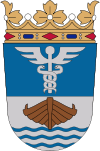Jyväskylä
| Jyväskylä | ||
|---|---|---|
| City | ||
| Jyväskylän kaupunki | ||
 | ||
| ||
 | ||
| Coordinates: 62°14.5′N 025°44.5′E / 62.2417°N 25.7417°ECoordinates: 62°14.5′N 025°44.5′E / 62.2417°N 25.7417°E | ||
| Country | Finland | |
| Region | Central Finland | |
| Sub-region | Jyväskylä sub-region | |
| Charter | 1837 | |
| Government | ||
| • City manager | Timo Koivisto[1] | |
| Area (2011-01-01)[2] | ||
| • City | 1,466.34 km2 (566.16 sq mi) | |
| • Land | 1,170.99 km2 (452.12 sq mi) | |
| • Water | 295.35 km2 (114.04 sq mi) | |
| • Urban | 99,25 km2 (3,832 sq mi) | |
| Area rank | 70th largest in Finland | |
| Population (2014-11-30)[3] | ||
| • City | 135,762 | |
| • Rank | 7th largest in Finland | |
| • Density | 115.94/km2 (300.3/sq mi) | |
| • Urban | 117,974 | |
| • Urban density | 1,188.7/km2 (3,079/sq mi) | |
| Population by native language[4] | ||
| • Finnish | 96.7% (official) | |
| • Swedish | 0.2% | |
| • Others | 3% | |
| Population by age[5] | ||
| • 0 to 14 | 16.4% | |
| • 15 to 64 | 69.8% | |
| • 65 or older | 13.8% | |
| Time zone | EET (UTC+2) | |
| • Summer (DST) | EEST (UTC+3) | |
| Municipal tax rate[6] | 19% | |
| Unemployment rate | 11.8% | |
| Website | www.jyvaskyla.fi | |
Jyväskylä (Finnish pronunciation: [ˈjyvæsˌkylæ]) is a city and municipality in Central Finland in the western part of the Finnish Lakeland. It is the largest city in Central Finland and on the Finnish Lakeland. Jyväskylä is located on the northern coast of Lake Päijänne, 147 kilometres (91 mi) north-east of Tampere and 270 kilometres (170 mi) north of Helsinki. The hilly and forested terrain in Jyväskylä is surrounded by hundreds of lakes.
Elias Lönnrot, the compiler of the Finnish national epic Kalevala, gave the city a nickname "Athens of Finland". This nickname is used to describe the major role of Jyväskylä as an education centre and the first place in the world to provide education in Finnish.[7]
The works of the most famous Finnish architect Alvar Aalto can be seen throughout the city. The city hosts Neste Oil Rally Finland, which is part of the World Rally Championship. It is also home of the annual Jyväskylä Arts Festival.
As of 30 November 2014, Jyväskylä had a population of 135,762.[3] The city has been one of the fastest growing cities in Finland since World War II. In 1940 there were only 8000 inhabitants in Jyväskylä. The Jyväskylä sub-region includes Jyväskylä, Hankasalmi, Laukaa, Muurame, Petäjävesi, Toivakka and Uurainen.
History



In the Jyväskylä region, there are archeological findings from the Stone Age. According to the oldest available taxation documents (maakirja) there were seven estates on the Jyväskylä region in 1539. One of them, the estate of Mattila, alone possessed the areas stretching from the village of Keljo to the villages of Vesanka and Palokka. The oldest estate in Jyväskylä continuously held by the same family is the estate of Lahti, which emerged when the estate of Mattila was split for two brothers in 1600.[8] The history of the estate of Lahti and the family of Lahti have had a significant impact on the development of Jyväskylä region. Lahdenrinne in the south-west corner of Jyväsjärvi lake belongs to the old heartland of the estate of Lahti.
The City of Jyväskylä was founded on 22 March 1837 by Czar Nicholas I of Russia and the infrastructure was essentially built from scratch. The original town was built between Lake Jyväsjärvi (which is connected to Lake Päijänne) and the Jyväskylä ridge (Harju), and consisted of most of the current grid-style city centre.
The establishment of schools in the 1850s and 1860s proved to be the most important step from the point of view of the later development of Jyväskylä. The first three Finnish-speaking schools in the world were founded in Jyväskylä, the lycée in 1858, the teachers’ college in 1863, and the girls’ school in 1864. Well-trained teaching staff and pupils from different parts of the country changed the atmosphere of Jyväskylä irrevocably.[9]
In the early 20th century, the town expanded several times. Most of today's Jyväskylä was built after the Continuation war, when refugees from Karelia and other parts of the country moved to the city and housing was badly needed. During 21st century Jyväskylä has grown fast – by over 1,000 inhabitants every year.[10]
Säynätsalo was consolidated with Jyväskylä in 1993. Jyväskylän maalaiskunta and Korpilahti, for their part, on January 1, 2009.
Etymology
The second part of the city's name, kylä, means village. The first part of the city's name, jyväs, has been associated with Taxus, a genus of yews, and the Old Prussian word juwis. It has also been speculated that the word jyväs refers to the sun's reflection of the surface of the water.[11]
Government
The city council in Jyväskylä is the main decision making body in local level. Its 75 members are elected every fourth year in municipal elections. The city council elects the mayor. The current mayor is Timo Koivisto.[1]
Seat distribution in the city council
| Party | Seats 2012 | 2012% | 2008% | 2004% | 2000% | 1996% | 1992% | 1988% | 1984% | 1980% | 1976% |
|---|---|---|---|---|---|---|---|---|---|---|---|
| Social Democrats | 17 | 24,1% | 26,6% | 29,9% | 31,9% | 33,7% | 35,8% | 33,3% | 32,4% | 33,0% | 33,1% |
| National Coalition Party | 13 | 18,6% | 21,0% | 20,0% | 20,6% | 22,9% | 20,0% | 25,7% | 25,4% | 25,7% | 23,8% |
| Centre Party | 11 | 17,0% | 19,1% | 19,1% | 17,3% | 13,3% | 10,2% | 12,1% | 12,1% | 9,7% | 7,0% |
| True Finns | 8 | 11,6% | 4,5% | 0,3% | - | - | 2,8% | 4,2% | 4,8% | 1,1% | 1,1% |
| Green League | 7 | 11,1% | 11,7% | 11,5% | 11,4% | 10,3% | 10,0% | 2,8% | 3,7% | - | - |
| Left Alliance | 6 | 9,2% | 8,5% | 9,0% | 9,6% | 11,0% | 13,3% | 15,7% | 16,5% | 19,8% | 22,1% |
| Christian Democrats | 4 | 5,7% | 5,8% | 6,3% | 6,9% | 7,1% | 5,2% | 4,0% | 4,3% | 5,4% | 5,6% |
| Communist Party | 1 | 1,8% | 2,4% | 3,5% | 1,9% | 1996% | 1992% | - | - | - | - |
| Pirate Party | 0 | 0,8% | - | - | - | - | - | - | - | - | - |
| Swedish People's Party | 0 | 0,0% | 0,2% | 0,2% | 0,2% | 0,3% | 0,4% | 0,6% | 0,6% | 0,6% | - |
| Others | 0 | 0,2% | 0,1% | 0,1% | 0,2% | 1,5% | 2,3% | 1,7% | 0,1% | 4,7% | 7,3% |
Administrative division
The city of Jyväskylä, is divided into fourteen wards (suuralueet in Finnish, storområden in Swedish), which are further divided into 89 districts. The ward division does not always follow district boundaries.

This is a listing of the 14 wards of Jyväskylä by population as of November 2010[12]
- 1. Kantakaupunki (city centre), population 25,149
- 2. Kuokkala, population 16,904
- 3. Vaajakoski-Jyskä, population 14,588
- 4. Palokka-Puuppola, population 14,395
- 5. Kypärämäki-Kortepohja, population 10,537
- 6. Huhtasuo, population 8,691
- 7. Keltinmäki-Myllyjärvi, population 7,524
- 8. Keljo, population 5,494
- 9. Halssila, population 5,479
- 10. Tikkakoski-Nyrölä, population 5,401
- 11. Korpilahti, population 4,993
- 12. Lohikoski-Seppälänkangas, population 4,650
- 13. Säynätsalo, population 3,340
- 14. Kuohu-Vesanka, population 2,118
Geography
.jpg)
Jyväskylä is located in the Finnish Lakeland. There are 328 lakes in the city. Lakes and rivers constitute 20,1% (295 km2) of the total area of the city. Biggest lakes are Päijänne, Leppävesi, Tuomiojärvi, Palokkajärvi, Luonetjärvi and Alvajärvi-Korttajärvi. The city centre is located on the shores of a small Jyväsjärvi.[13]
The landscape in Jyväskylä is hilly, forested and full of waters. The architect Alvar Aalto compared the hilly landscape of Jyväskylä to Toscana in Italy: "The slope of Jyväskylä ridge is almost like the mountain vineyards of Fiesole".[14]
Climate
Because of its northern location, winters are long, snowy, cold and dark. However, when compared to other locations at these latitudes, for example in Russia and Canada, Jyväskylä has significantly milder winter temperatures. During midwinter the city receives daylight for only around five hours. Summers are mild and with the average daily maximum temperature being 22 °C (72 °F) in July. During the summer Jyväskylä experiences long daylight and white nights i.e. midnight twilight.
| Climate data for Jyväskylä | |||||||||||||
|---|---|---|---|---|---|---|---|---|---|---|---|---|---|
| Month | Jan | Feb | Mar | Apr | May | Jun | Jul | Aug | Sep | Oct | Nov | Dec | Year |
| Average high °C (°F) | −5.1 (22.8) |
−4.7 (23.5) |
0.4 (32.7) |
7.0 (44.6) |
14.8 (58.6) |
19.0 (66.2) |
21.8 (71.2) |
19.0 (66.2) |
13.0 (55.4) |
6.4 (43.5) |
0.3 (32.5) |
−3.3 (26.1) |
7.4 (45.3) |
| Daily mean °C (°F) | −8.55 (16.61) |
−8.7 (16.3) |
−2.15 (28.13) |
2.15 (35.87) |
8.75 (47.75) |
13.45 (56.21) |
16.35 (61.43) |
14.1 (57.4) |
8.85 (47.93) |
3.6 (38.5) |
−2.1 (28.2) |
−6.4 (20.5) |
3.279 (37.902) |
| Average low °C (°F) | −12 (10) |
−12.7 (9.1) |
−8.3 (17.1) |
−2.7 (27.1) |
2.7 (36.9) |
7.9 (46.2) |
10.9 (51.6) |
9.2 (48.6) |
4.7 (40.5) |
0.8 (33.4) |
−4.5 (23.9) |
−9.5 (14.9) |
−1.1 (30) |
| Average precipitation mm (inches) | 45 (1.77) |
32 (1.26) |
36 (1.42) |
35 (1.38) |
44 (1.73) |
67 (2.64) |
84 (3.31) |
78 (3.07) |
55 (2.17) |
66 (2.6) |
54 (2.13) |
47 (1.85) |
643 (25.31) |
| Source: Climatological statistics for the normal period 1981–2010[15] | |||||||||||||
Cityscape


Jyväskylä was founded in the Northern end of the lake Päijänne at the crossroads of three major waterways. Lakes control the cityscape.[9] The city grid plan from year 1833 by Jacob Leonard Boringh can be well recognised in the city centre.[16] Nevertheless, due to very rapid population growth the cityscape has gone through one of the most massive changes in all of Finland.[17]
Nowadays Jyväskylä is a city of modern architecture. The city has more buildings designed by one of the best known international functionalist architects Alvar Aalto than any other city in the world.[18]
The establishment of schools in the 1850s and 1860s proved to be the most important step from the point of view of the later development of Jyväskylä.[9] The headquarters of the University of Jyväskylä are considered to be Aalto's masterpieces. Later, a modern architect Arto Sipinen, a pupil of Aalto, has influenced in the cityscape since the 1970s by designing most of the new university buildings in the city.
The outskirts of the city are mainly populated by student apartments and single-family houses. Some of the most important buildings like Säynätsalo Town Hall designed by Aalto are located outside the city centre in Säynätsalo and Muuratsalo.
Consolidated areas Korpilahti, Jyväskylän maalaiskunta, Säynätsalo and also western parts of Jyväskylä are mainly countryside dominated by hilly forests and lakes.


Demographics
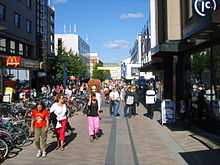
Population
Jyväskylä was the fastest growing Finnish city in the 20th century. The population has continued to grow rapidly in the 21st century.[19][20][21]
| Year | 1838 | 1850 | 1860 | 1900 | 1939 | 1952 | 1960 | 1970 | 1990 | 1997 | 2010 |
|---|---|---|---|---|---|---|---|---|---|---|---|
| Population of Jyväskylä | 189 | | | | | | | | | | |
Languages
Finnish is the predominant language spoken in Jyväskylä. 96.7% of the population spoke Finnish as their mother language in 2010. The share of Swedish speaking was 0.2% and other languages was spoken by 3% of the population.
Nationalities
In year 2014, there were about 3700 foreigners in Jyväskylä. Biggest immigrant groups in Jyväskylä are Russians, Estonians and Afghans.[22]
Economy



Because of excellent connections Jyväskylä was a busy market place even before first permanent settlements were founded in the current city centre. The establishment of Finland’s first three Finnish-speaking schools: the lycée in 1858, the teachers’ college in 1863, and the girls’ school in 1864 proved to be the most important steps from the point of view of the later development of Jyväskylä. Educational services became a heart of the economic growth of the city. In 1912 Wilhelm Schauman founded a plywood mill on the shores of Jyväsjärvi. Soon also other kind of forest based businesses opened factories and premises in the city. Thus, forest, pulp and paper became the second stronghold of the economy in Jyväskylä. Later the high quality education and paper machinery industry tempted information technology businesses to settle in the city.[9]
Nowadays main sources of livelihood in Jyväskylä are educational and health care services, paper machinery production, information technology and renewable energy. Most important private employers are paper machinery producer Metso ltd., retail trade company Keskimaa Cooperative Society, real estate service company ISS and wind turbine gear manufacturer Moventas.[23] Biggest public employers are the City of Jyväskylä, Central Finland Health Care District, University of Jyväskylä and the Air Force Academy.
As of 2010 only 1% of the labour force work on the primary sector, 21% on the secondary sector, and 78% on the service sector of the economy.[24]
In April 2012 the unemployment rate in Jyväskylä was 12.2%, which was higher than average in Finland (9,8% in 1/2012),[25] due to the high number of students and challenged industries.[26] As of July 2012 there were about 61.000 jobs in Jyväskylä. The average income per income earner was €24,380 in 2010.[27]
In 2011 Jyväskylä topped in an image evaluation research among businesses. The city reached the highest score of Finnish big cities in the research succeeding especially on availability of skilled work force, on commercial services, on transport connections and on geographical location.[28]
The Gross domestic product per capita in the city of Jyväskylä was 33.688 € in 2005. The self-sufficiency in workplaces exceeded 100% in the city raising the GDP per capita higher than the national average. The GDP per capita of the whole Jyväskylä region was 28.718 € in 2007. The regional GDP per capita is lower than the Finnish national average mainly due to high number of students and a relatively high unemployment rate.[29]
Sports

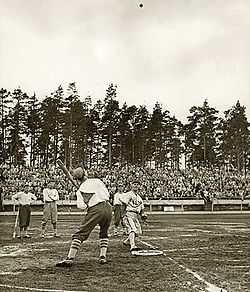

The University of Jyväskylä is the only university in Northern Europe with a faculty of sports. The faculty has been a key player to develop a strong sports culture in the city.
The city hosts the Neste Oil Rally Finland (formerly known as 1000 Lakes Rally). It is the biggest annually organised public event in the Nordic countries, gathering over 500,000 spectators every year. The rally has been held since 1951, first as a national competition, then from 1959 on as a European Rally Championship event and since the introduction of the World Rally Championship in 1973, as Finland's WRC event.
Ice hockey venue Synergia-areena, Hippos Finnish baseball stadium, swimming hall AaltoAlvari and many other main sport venues of the city are located in Hippos two kilometres (1.2 miles) away from the city centre. Matti Nykänen ski jumping hill is located next to the Laajavuori ski resort just few kilometres west from the city centre. Main football stadium lies on the slopes of Harju just next to the city centre. Killeri hippodrome on the western parts of the city serves different horse racing competitions. At winter time amateur ice skaters can practice their skills in Viitaniemi or on the lake Jyväsjärvi, which has a 3.5 km (2.2 mi) long ice skating track.
The inventor of Finnish national sport pesäpallo, Lauri "Tahko" Pihkala studied and lived in Jyväskylä. The Upper secondary school of Jyväskylän Lyseo hosted the historic event of first pesäpallo match in world in September 1920.[30][31]
Sporting teams from Jyväskylä include:
- JYP is the 2009 and 2012 Finnish Champion in ice hockey.
- Jyväskylän Jalkapalloklubi (JJK Jyväskylä) plays in Ykkönen, the second highest division of Finnish football.
- JyPK, Jyväskylän Pallokerho is women's football team playing in the second tier of the Finnish football league system.
- FC Vaajakoski plays in Kakkonen, the third tier of the Finnish football league system.
- FC Blackbird plays in Kolmonen, the fourth tier of the Finnish football league system.
- Jyväskylän Seudun Palloseura (JPS) plays in the highest bandy division, bandyliiga.
- Jyväskylä Track and Field Club (JKU) is one of the leading track and field clubs in Finland.
- Jyväskylän Kiri is the most successful Finnish baseball team in history. Currently they play in the top division Superpesis.
- Jyväskylän Saukot plays water polo in the Finnish top division both in men and women.
- Kampuksen Dynamo (KaDy) plays futsal in the Finnish top league.
- Kirittäret holds ten Finnish Championships in women's Finnish baseball league. Latest championship is from summer 2010.
- Jyväskylän seudun Jaguaarit plays in the top division of Finnish American football league.
- Happee plays floorball in the Finnish top division both in men's and women's league. Men´s Finnish Championship in 2014.
- Hongikon Nuorisoseuran Urheilijat plays basketball in the Finnish first division in men's league and in women's league
- Jyväskylä Freestyle Club is the main freestyle skiing club.
- Jyväskylä Ski Club (JHS) is one of the most well known cross-country skiing, ski-jumping, alpine skiing, snowboarding, Nordic combined and biathlon clubs in Finland.
- [hMeloiloa Canoe Club]: plays canoe polo, and practices whitewater slalom, canoe racing, wildwater canoeing and marathon kayaking..
- [hJyväskylä Rugby Club]: plays rugby union (rugby) at the highest national league. Former national champions.
- [ Jyväskylän Fight Club]: is the city's most successful martial arts and Brazilian Jiu-Jitsu academy.
- [Jigotai]: is the biggest martial arts club in Central Finland. (judo, karate, kickboxing, t'ai chi, aikido, taido etc.)
- [ Mukwan] is a well-known Taekwondo martial arts club in Jyväskylä since 1984.
- Liikunnan Riemu plays futsal in the Finnish top league since 2013.
- Jyväskylän Liitokiekkoilijat Ry (JyLi Ry) is a disc sports club, main sports represented are Ultimate and Disc golf.
Culture
Museums


_K-SIM_02.jpg)
The Alvar Aalto Museum and the Museum of Central Finland form a centre of culture in the immediate vicinity of the historical campus of the University of Jyväskylä. Both museums are designed by a functionalist Alvar Aalto. The Alvar Aalto Museum displays the artist's most important work and design. The Museum of Central Finland specializes in cultural history. It serves both as the town museum of Jyväskylä and the provincial museum of Central Finland.
One of architect Aalto's most significant works Säynätsalo Town Hall is located in Säynätsalo island.
The Craft Museum of Finland is a handicraft museum covering entire Finland. The Centre for Finnish National Costumes forms a part of the museum.
The Aviation Museum of Central Finland near the Jyväskylä Airport in Tikkakoski exhibits the aviation history of Finland.
The University of Jyväskylä Museum is specialized in history of the University and diversity of nature in Central Finland.
The biggest art museum in the city is Jyväskylä Art Museum located in the city centre. Another art museum centre – The Halonen building – near the main railway station consists of The Centre for Creative Photography, the Centre for Printmaking and Galleria Harmonia.
Also churches in the city are open for public, most notables of them being the Taulumäki Church and the Jyväskylä City Church.
Theatres
The biggest theatre in the city is the Jyväskylä City Theatre designed by Alvar Aalto. It stands right in the centre of the city. Jyväskylä Workers' Theatre is located in Ainola on the Eastern side of the lake Jyväsjärvi. Huoneteatteri, founded on the aftermath of the II World War is the third remarkable theatre in Jyväskylä.
Annual Events

- Arctic and Fabulous Film Festival offers different forms and genres of Nordic film in the middle of most freezing winter season in February.
- Jyväskylä City's Birthday Week (last week of March) offers a number of concerts, theatre, exhibitions and debates around the city.
- Jyrock in April is an indie and alternative rock and pop festival.
- Yläkaupungin Yö in May is one of the biggest annual street festivals of the city.
- Sataman Yö is an annual pop music festival organised one week before the midsummer in the harbour of Jyväskylä.
- Jyväskylä Arts Festival in the middle of July accommodates musicians, bands, contemporary circus, comedians, mimes, physical theatre, storytellers and film makers. It is one of the most well known festivals in Finland.
- Neste Oil Rally Finland in the end of July is the biggest annually organised event in Nordic countries and a part of the WRC World Rally Championships.
- Athenis Finlandiae organised in August is a cultural festival combining elements from ancient history, arts and science.
- Finlandia Marathon in the beginning of September is a marathon festival designed for everybody from a top athlete to an amateur jogger. Time of Dance – the largest annual festival of Finnish contemporary dance is taking place in the end of September.
- The International Print Triennal Graphica Creativa is organised every three years since 1975. It was the very first international graphic art exhibition in Finland. The next triennal will be organised 2012.
Education
Jyväskylä is a traditional education city. Including school children, and the students in high schools, vocational schools, the university of applied sciences and the universities, the number of students and pupils in the city reaches 45,000, boosting Jyväskylä's reputation as a "student city". Over 30% of the city population are students.[32] A number of firsts in Finnish education have taken place in Jyväskylä:
- Jyväskylä Lyceum (Finnish: Jyväskylän Lyseon lukio) is the world's first junior secondary school with Finnish as the language of instruction. It started its first term on October 1 in 1858. Lyceum is still existing and it is one of nine upper secondary schools in the city.

- The first Finnish-medium teacher training college (1863)
- The first Finnish-medium school for girls (1864)
- Finland's first Summer University (1912)
Due to this, among other things, the city has earned the nickname Athens of Finland.
The teacher training college later evolved into the College of Education (1934) and further into the multidisciplinary University of Jyväskylä (1966).
The University of Jyväskylä is one of the most popular universities in Finland. Almost 16,000 students are enrolled to study for a Bachelor's or Master's degree, and the university also offers PhD programs in most of its subjects. Historically, the university has excelled in the study of education, but in the last few decades it has also gained respect in the sciences. It is the only university in Finland offering university-level education in sports, training sports teachers and coaches. Its IT program is the largest in the country in terms of attendance.
JAMK University of Applied Sciences has 8.000 students. It has four different units: School of Business and Services Management, School of Health and Social Studies, School of Technology and Teacher Education College.[33] HUMAK University of Applied Sciences educates cultural management in Jyväskylä.
Transport

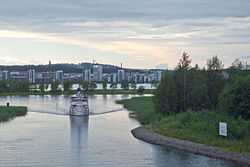
Jyväskylä railway station is served by VR direct trains to Helsinki, Pieksämäki, Tampere, Turku, Vaasa and many other destinations in Finland. The station was extensively modernised in 2002.
Jyväskylä Airport is situated in Tikkakoski, about 20 kilometres (12 mi) north of Jyväskylä. It has regular direct flights to Helsinki-Vantaa Airport. The airport serves also as a military and charter airport.
The city is on crossroads of many main roads of Finland. European route E75 passes the city from South to North and E63 from Southeast to Northwest.
Jyväskylä harbour is home for many passenger ships operating on lake Päijänne. On summer time there are direct ship connections to Lahti, Jämsä, Suolahti, Viitasaari and some other cities.
The public transportation system is operated by Jyväskylän liikenne and it is based on bus lines.
In 2009 the modal share of the city was dominated by cars (61%). The modal split of pedestrians 20% and bicyclers 13% is relatively high compared to other Finnish cities. Public transportation had 4% modal share.[34]
Former city managers
- Varma T. Suosalmi 1930–1935
- Arvo Haapasalo 1935–1955
- Jorma Tuominen 1955–1959
- Veli Järvinen 1959–1974
- Jaakko Loven 1975–1994
- Pekka Kettunen 1994–2004
- Markku Andersson 2004–2015[35]
People
Creative artists
Politicians
|
Engineers/Aviators
Athletes
Bands
|
International relations

Twin towns — Sister cities — Friendship cities
Jyväskylä is a member city of Eurotowns network[36] and is twinned with:
|
Gallery
-

The city is located on the shores of Jyväsjärvi, the Northern end of Lake Päijänne
-

Korpilahti was consolidated to Jyväskylä in 2009. Photo from Putkilahti village.
-

Sääksjärvi, one of the numerous lakes in the city
-
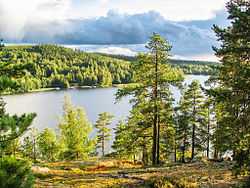
Lake Päijänne in Muuratsalo
-

Säynätsalo Harbour
-

Köyhälampi pond
-

Lake Tuomiojärvi
-
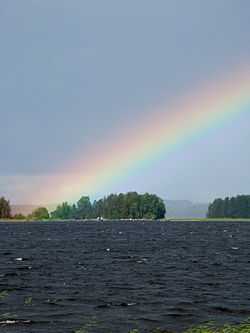
Lake Leppävesi
-

Lake Kangaslampi
-

Jyväskylä ski jump
-

View from the Harju Stairs
-
Killeri harness racing track during the Neste Rally Finland 2007
-

Vesilinna tower on top of Harju
-

Experimental house by Alvar Aalto in Muuratsalo
-

Kauppakatu street in the city centre in 2006
-

Markus Grönholm drives his Ford Focus WRC out of the service park at Paviljonki during Neste Rally Finland 2006.
-

A street view from Lutakko neighbourhood
-

Wooden terraced houses in Säynätsalo
-
Old fighter aircraft in the Aviation Museum of Central Finland
-

Kuokkala Church
-

Taulumäki Church designed by architect Elsi Borg
-

Kuokkala Bridge
-

Jyväskylä harbour area
See also
- Asteroid 1500 Jyväskylä (named after the town by its Finnish discoverer, Yrjö Väisälä).
References
- ↑ 1.0 1.1 Timo Koivistosta Jyväskylän uusi kaupunginjohtaja Yle. 10 Nov 2014. (Finnish)
- ↑ "Area by municipality as of 1 January 2011" (PDF) (in Finnish and Swedish). Land Survey of Finland. Retrieved 9 March 2011.
- ↑ 3.0 3.1 "VÄESTÖTIETOJÄRJESTELMÄ REKISTERITILANNE 30.11.2014" (in Finnish and Swedish). Population Register Center of Finland. Retrieved 29 December 2014.
- ↑ "Population according to language and the number of foreigners and land area km2 by area as of 31 December 2008". Statistics Finland's PX-Web databases. Statistics Finland. Retrieved 29 March 2009.
- ↑ "Population according to age and gender by area as of 31 December 2008". Statistics Finland's PX-Web databases. Statistics Finland. Retrieved 28 April 2009.
- ↑ "List of municipal and parish tax rates in 2011". Tax Administration of Finland. 29 November 2010. Retrieved 13 March 2011.
- ↑ Tervoja, Pia (August 2008). "Bene veniatis in urbem Jyväskylä". City of Jyväskylä. Retrieved 27 February 2012.
- ↑ Berndtson, Nils (1983), = Lahden talon ja suvun varhaisista vaiheista, Keski-Suomen museon monistesarja 2/1983 (2), Jyväskylän kaupunki, Finland: Keski-Suomen museo, pp. 1–23, ISSN 0357-8186
- ↑ 9.0 9.1 9.2 9.3 Jäppinen, Jussi; Voutilainen, Heli-Maija (2003). "Schools for non-Swedish Speakers". From Marketplace to a Wonderful Town - A Brief Introduction to the History of Jyväskylä. City of Jyväskylä. Retrieved 26 February 2012.
- ↑ "Jyväskylän kaupungin väestöarvio". Väestötilastoja. City of Jyväskylä. 2012. Retrieved 15 September 2012.
- ↑ Kosonen, Ilmari (28 February 2005). "Miten Sissoset muinoin saivat nimensä jousipuusta?". Saunan synty. Sissosten sukuseura ry. Retrieved 26 February 2012.
- ↑ "Tietoja Jyväskylästä suuralueittain". Tietoja Jyväskylästä suuralueittain. City of Jyväskylä. 7 July 2011. Retrieved 26 February 2012.
- ↑ "Jyväskylä". Järviwiki. Finland's Environmental Administration. 2012. Retrieved 26 February 2012.
- ↑ Nature and space: Aalto and Le Corbusier. Routledge. 2003. Retrieved 2010-07-17.
- ↑ Finnish Meteorological Institute (2011). "Tilastoja Suomen ilmastosta - Climatological Statistics of Finland". Finnish Meteorological Institute. Retrieved 26 February 2012.
- ↑ Arja Liinamaa (16 March 2005). "Kaunis kaupunki selkeytyy". Jyväskylä lehti. City of Jyväskylä. Retrieved 26 February 2012.
- ↑ Liisa Harjula (March 2005). "Summary: Have you ever seen a beautiful town?". Väitös: Jyväskylän keskustan kaupunkirakenne hajosi 1950-70-luvuilla (Jäppinen). University of Jyväskylä. Retrieved 26 February 2012.
- ↑ "Travel in Jyväskylä Region - Places to Visit". Jyväskylä Regional Tourist Information. 2012. Retrieved 26 February 2012.
- ↑ "A short history of Jyväskylä". A short history of Jyväskylä. City of Jyväskylä. Retrieved 2011-12-02.
- ↑ "Jyväskylän kaupungin elinkeinoelämän vaikuttavuus 1990-luvulla" (PDF). Jyväskylän kaupungin elinkeinoelämän vaikuttavuus 1990-luvulla. University of Jyväskylä.
- ↑ "Mouvement de la Population de Finlande en 1939" (PDF). Official Finnish population statistics 1939. Finnish Government.
- ↑ "City of Jyväskylä: For immigrants". City of Jyväskylä. 2014. Retrieved 2 February 2015.
- ↑ "Jyväskylä 2011". City of Jyväskylä. 2 December 2011. Retrieved 26 February 2012.
- ↑ "Business". City of Jyväskylä. 25 June 2012. Retrieved 9 July 2012.
- ↑ Lauri Hiltunen (21 February 2012). "Keski-Suomen työllisyyskatsaus tammikuu 2012". Central Finland Centre for Economic Development, Transport and the Environment. Retrieved 26 February 2012.
- ↑
- ↑ "Jyväskylä pähkinänkuoressa". City of Jyväskylä. 25 June 2012. Retrieved 9 July 2012.
- ↑ Anna Kivinen (2 December 2011). "Jyväskylän imago kestää edelleen". Keskisuomalainen. Retrieved 26 February 2012.
- ↑ Erkki Niemi (2 September 2009). "Faktoista tulevaisuudeksi - muutosten fundamentit; Aluetaloudet ja työssäkäyntialueet faktojen valossa" (PDF). Statistics Finland. Retrieved 26 February 2012.
- ↑ Karhunen, Marjo; Kettunen, Marja; Villaume, Marie; Claudel, Stéphanie (28 May 2002). "Sports: Jyväskylä and Epinal". Epinal and Jyväskylä: Town History Project. Jyväskylä Lyceum. Retrieved 26 February 2012.
- ↑ Esa Sironen (2001–2003). "Kun pesäpallosta tuli pesäpalloa". Pitkäpallosta playoffseihin. Suomalaisuuskeskus Finnica. Retrieved 26 February 2012.
- ↑ "Tervetuloa opiskelemaan Jyväskylään". City of Jyväskylä. 2012. Retrieved 26 February 2012.
- ↑ "Creating Competence". JAMK University of Applied Sciences. 25 January 2011. Retrieved 26 February 2012.
- ↑ Markku Kivari (31 May 2010). "Jyväskylän Seudun liikenne 2025" (PDF). Regional Council of Central Finland. Retrieved 26 February 2012.
- ↑ http://yle.fi/uutiset/andersson_elakkeelle__jyvaskyla_pohtii_pormestaria/7117291
- ↑ "Eurotowns".
- ↑ "Die Partnerstädte der Landeshauptstadt Potsdam". www.potsdam.de (in German). Retrieved 24 June 2010.
- ↑ "Poznań - Miasta partnerskie". 1998–2013 Urząd Miasta Poznania (in Polish). City of Poznań. Archived from the original on 2013-09-23. Retrieved 2013-12-11.
- ↑ "Poznań Official Website - Twin Towns".
 (in Polish) © 1998–2008 Urząd Miasta Poznania. Retrieved 2008-11-29.
(in Polish) © 1998–2008 Urząd Miasta Poznania. Retrieved 2008-11-29. - ↑ "Twin Cities". City of Jyväskylä. 2012. Retrieved 26 February 2012.
- ↑ Terhi Saranen (31 August 2005). "Ystävänä kaupunki". Jyväskylä lehti. Retrieved 26 February 2012.
Literature
- History
- Kokko, Marja (2007). Jyväskylän kaupungin historia 1965–2007 (in Finnish). Helsinki: City of Jyväskylä. ISBN 978-952-5332-96-4.
- Tommila, Päiviö (1970). Jyväskylän kaupungin historia 1837–1965 (in Finnish) II. Jyväskylä: City of Jyväskylä. ISBN 951-95011-0-X.
- Tommila, Päiviö (1972). Jyväskylän kaupungin historia 1837–1965 (in Finnish) I. Jyväskylä: City of Jyväskylä. ISBN 951-95011-2-6.
External links
| Wikimedia Commons has media related to Jyväskylä. |
- City of Jyväskylä – International version of the official website
- Map of Jyväskylä
- Region of Jyväskylä Tourist Information
| |||||||||||||||||
| |||||||||||||||||||||||||||||||||||||||||||||||||||||||||||||||||||||||||||||||||||||||||||||||||||||||||||||||||||||||||||||||||||||||
